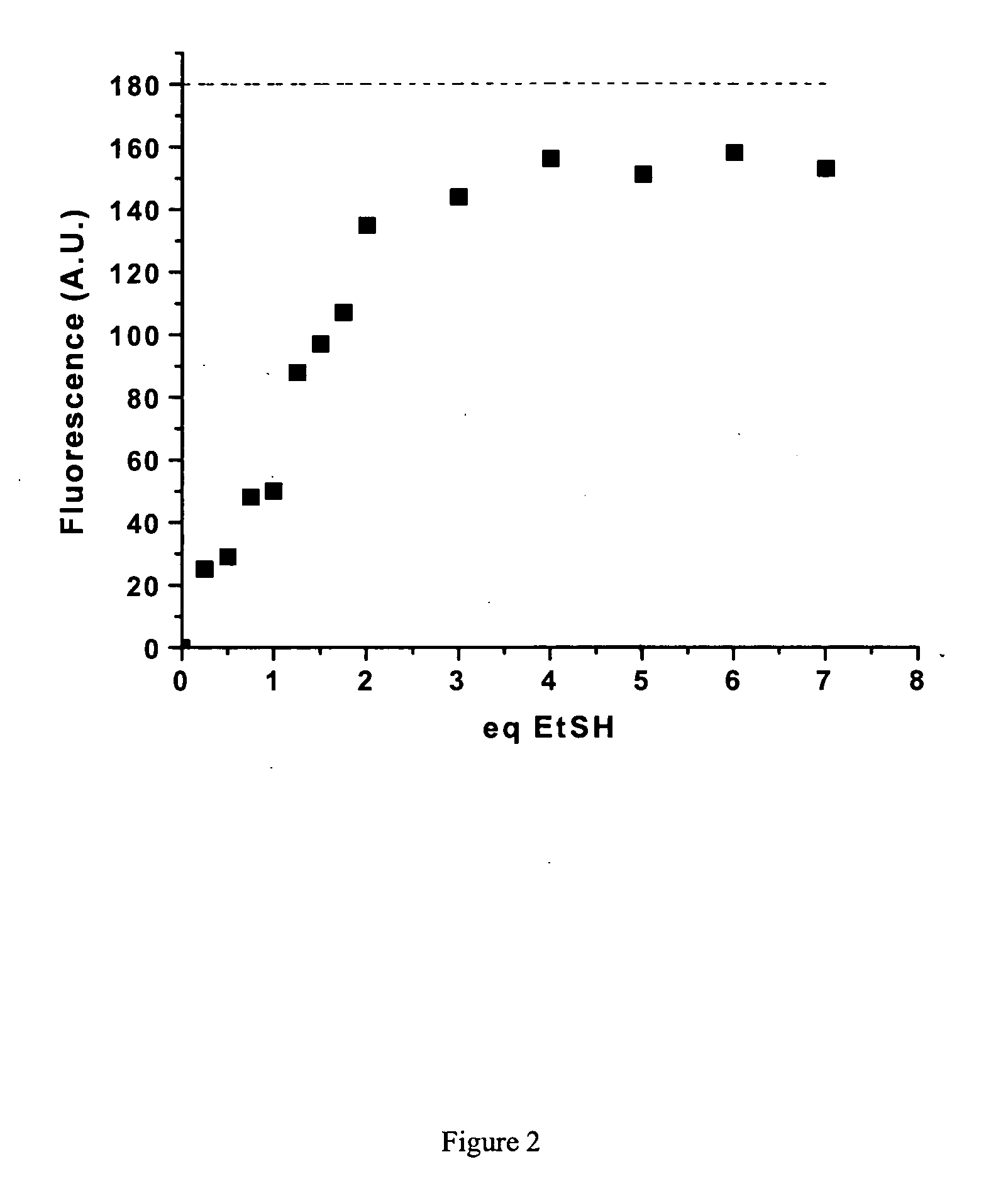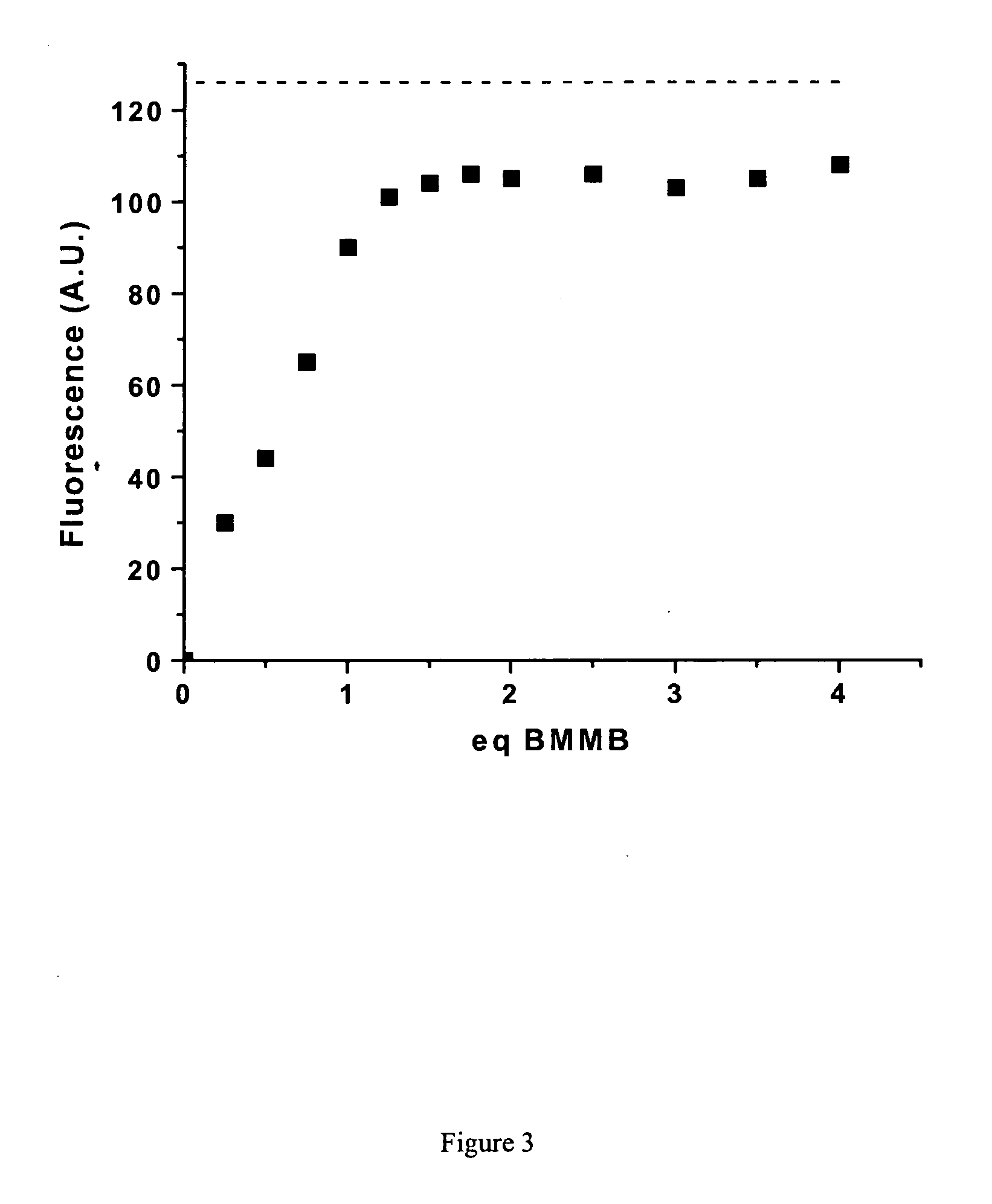Fluorescent labeling of specific protein targets in vitro and in vivo
a technology of specific protein and fluorescent labeling, applied in the field of determining the function of novel gene products, can solve the problems of limited in vitro application, not necessarily providing information pertinent to living cells, and the ‘expression cloning’ approach remains a significant experimental challeng
- Summary
- Abstract
- Description
- Claims
- Application Information
AI Technical Summary
Benefits of technology
Problems solved by technology
Method used
Image
Examples
example 1
[0046] Purified mCys-Fos and diCys-Fos were then tested in vitro for their ability to react with fluorogens 13 and 20. After incubation of 0.242 mM protein with 0.5 mM of 20 or 0.05 mM of 13 at 25° C. overnight, glycerol was added and the reaction mixtures were analyzed by SDS-PAGE using UV illumination and then Coomassie blue staining. From the resulting gel shown in FIG. 5, it is clear that even under these extended reaction conditions, diCys-Fos is efficiently fluorescently labeled by either fluorogen, whereas mCys-Fos is not. Furthermore, the fluorogens tested do not react with two equivalents of mCys-Fos, as evidenced by the absence of a band corresponding to the molecular weight of the expected covalent dimeric protein-fluorogen adduct. This selectivity for reaction with one equivalent of dithiol, rather than two equivalents of monothiol, was also observed for small organic thiols and dithiols, as discussed above. Tsien has also remarked on this kinet...
example 2
[0048] The ultimate proof of principle for this method is its successful application to labeling a specific protein in living eukaryotic cells. To test for this potential, our diCys-Fos probe protein was genetically fused to RBD, the Ras-binding domain of Raf, and COS cells were then transfected with the expression plasmid for this fusion protein. A solution of 20 was then added to cultures of COS cells expressing diCys-Fos as well as mock COS cells transfected with an empty expression plasmid. At a final concentration of 10 μM 20, a significant difference in fluorescence was observed after 20 minutes of incubation at room temperature.20 As shown in FIG. 7, cells expressing diCys-Fos display the blue fluorescence typical of dithiol adducts of 20 far more than cells not expressing diCys-Fos, confirming the cell permeability of 20, the specificity of its reaction with our helical probe protein and the viability of this labeling method in vivo.
[0049] Finally, ...
example 3
Second and Third Generation Fluorophores
[0050] In many respects, our previous results have already validated our fluorescent assay. For example, we have demonstrated the fluorogenic reaction of dimaleimide derivatives of coumarine and naphthalene fluorophores; other fluorogens are now being synthesized, along the same general synthetic pathways as those shown in Schemes 1-4. These second- and third-generation fluorogens will be evaluated for their solubility and cell permeability, as well as their fluorescent properties. These properties include the enhanced fluorescent intensity of their dithiolated adducts, their lack of fluorescence prior to their thiol addition reactions and the wavelengths of their fluorescent emission bands. The latter characteristic is important in order to allow the facile detection of their fluorescent thiolated forms against the background fluorescence of intracellular biomolecules. Several candidate fluorogens that may satisfy these criteria have been id...
PUM
| Property | Measurement | Unit |
|---|---|---|
| Nanoscale particle size | aaaaa | aaaaa |
| Nanoscale particle size | aaaaa | aaaaa |
| Nanoscale particle size | aaaaa | aaaaa |
Abstract
Description
Claims
Application Information
 Login to View More
Login to View More - R&D
- Intellectual Property
- Life Sciences
- Materials
- Tech Scout
- Unparalleled Data Quality
- Higher Quality Content
- 60% Fewer Hallucinations
Browse by: Latest US Patents, China's latest patents, Technical Efficacy Thesaurus, Application Domain, Technology Topic, Popular Technical Reports.
© 2025 PatSnap. All rights reserved.Legal|Privacy policy|Modern Slavery Act Transparency Statement|Sitemap|About US| Contact US: help@patsnap.com



